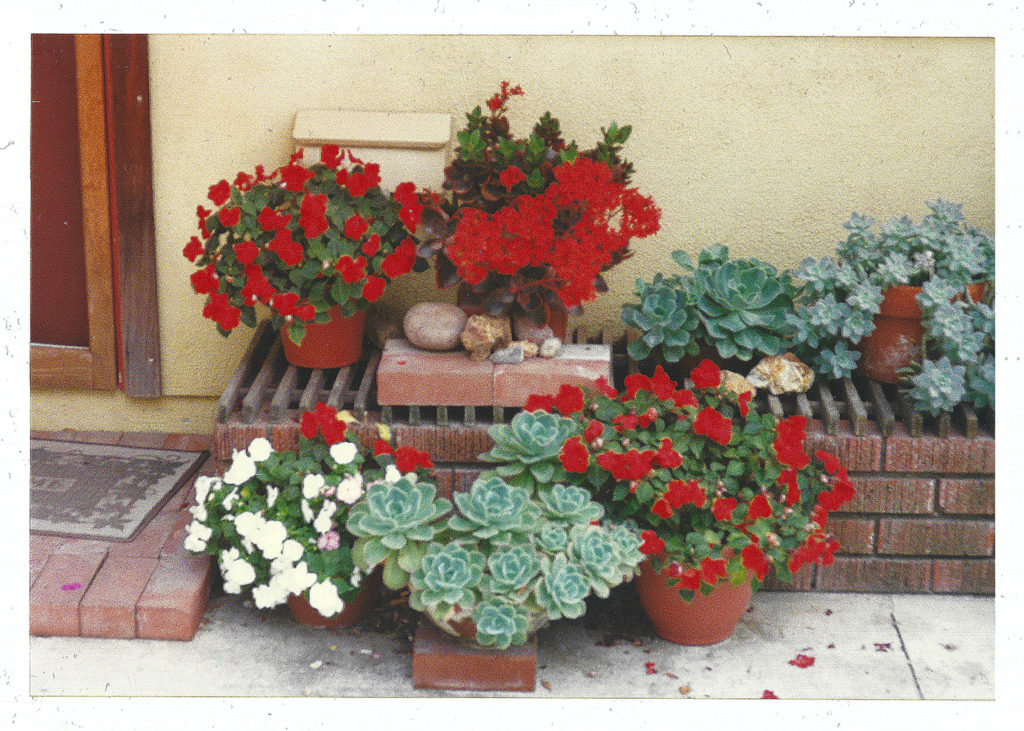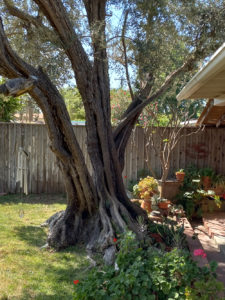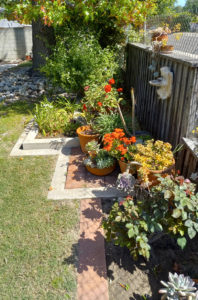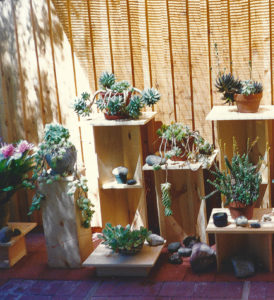
The house was three years old when we bought it in 1959, and we took possession on the weekend our daughter, Ravenna, turned two. My architect father was with us when we moved in. His sensibilities were not offended by the simple little tract house with the open beam ceiling. The plan was smart, and the house appeared to be well built. Its livability was not compromised by the fact that all the other houses up and down the street were just like ours.
While my wife Joy and I were looking around the house, deciding where to place our meager selection of furniture, we heard Ravenna giggling and laughing on the back porch. She had discovered—and had decorated herself with—a large gaggle of snails, nestled up and down her little bare legs and arms. Yes. That is why we wanted a gated back yard, a safe place for our young daughter to play.
One of the first things we did was remove the ivy that was growing up the porch posts. It was a snail haven. We followed other procedures to reduce the snail population. We did not consult Ravenna, who would not have been happy with what we had done with her friends.

Family friends gave Ravenna a little pine tree in a coffee can. Once in the ground, it grew like a boy headed for the NBA, at such a rapid pace that we had to remove it to avoid its complete domination of the back yard. Ravenna was not pleased when her tree was turned into firewood.
I planted a slender and supple Corymbia citriodora—the lemon-scented eucalyptus—unknowingly over the sewer line to the street. The eucalyptus was removed. The broken sewer pipe was replaced. We miss the smell of those leaves.
The concrete pad for our back porch floor measures twelve by twenty feet. We put together a picnic table and benches. Ravenna had a small table with two chairs. We also put our canvas officer’s chairs and a blue butterfly chair on the porch. Nice arrangement, especially since the snails had found other accommodations. The porch roof was a flimsy frame of two-by-fours, onto which were loosely nailed panels of translucent corrugated plastic. The roof rattled when the wind blew. A hard rain made a loud, clattering racket.
A wading pool and a sandbox were other additions. Ravenna and Joy both enjoyed the wading pool on hot days, since the house had no air conditioning. Ravenna and her friends had the sandbox to themselves.

Our son Bill was born in October of 1959. He first enjoyed the backyard from the safety of his playpen, watching Ravenna as she entertained the lizards who had accepted her invitation to a tea party. It was evident very early that Ravenna had an affinity for animals, and they for her. Not only the family cat and lizards, but guinea pigs, hamsters, mice and, a little later, frogs, snakes, a horned toad, a rat named Polyanna, two turtles named Green and Green, fish, and a rabbit.
The creatures needed habitation. The garage became a workshop where I built cages of all sizes for Ravenna’s fast-growing zoological agglomeration. Most of these cages were assigned to spots in the back and side yards. California’s climate allowed for this. Days of cold or wet could be dealt with by use of old slickers or blankets.
We had more ordinary pets, too: cats, a family of parakeets, and a canary named Alvin. When anyone sneezed, Alvin would chirp a tune. Long after Alvin was gone, if someone in the household sneezed, someone else would whistle Alvin’s tune.
From the time Bill was very small he would help me in the garage. We built a pair of sawhorses out of two-by-fours and three-quarter-inch plywood. Those horses have been used over the decades for every type of garden, construction, house painting, and mechanical project.
Our third child, Suzanne, was born in March of 1962. We had just bought and put together a swing set. Its two swings and rocking seesaw were immediately popular not only with our own children, but also children from up and down the block.
The back porch was the site of many parties and gatherings, and they varied over the years. The first years were mostly Saturday sandwiches and birthdays. For his eighth birthday party, Bill envisioned a major project: to turn the swing set into a sailing ship. By himself he gathered and requested materials. The ship was complete with tall masts, booms, sails, rigging, a rudder, and lines (which landlubbers call ropes.) With the swings in the center, the picnic benches became the sides of the hull, port and starboard. The partygoers stood in line to board the vessel.
Suzanne planted and nurtured nasturtiums beneath two large jade plants next to the outside bedroom wall. She was also the housekeeper for the back porch. She swept, dusted, and arranged the furniture and the potted flowers. Then rearranged them. And rearranged them again.

The two side yards have functioned in a variety of roles. The west side yard was where we grew string beans, sweet peas, and maintained a smoldering mulch pile. The east side yard was always gated and was a utilitarian thoroughfare between the front and back. I built a wood shed and a small storage structure there. They gave way to a garden workbench and vegetable garden. The back yard is where the family and friends could enjoy the natural world. Bill, especially, was an avid weather watcher. When it was windy and raining, he would be outside, getting wet and watching out for lightning.
We appreciated the scent of mowed grass and freshly watered flowers; the rustle of the liquidambar leaves in the fall, when the tree became large enough to provide a goodly harvest of leaves. The wild birds: the mockingbirds whistling out their endless and cheerful repertoire; the raspy voiced crows gathering to discuss current events in a raucous caucus; the sweetly cooing doves; and the flights of small birds chirping a vast array of avian utterances—plus the other birds, the light Cessnas that have flown in and out of the nearby Fullerton Airport for decades.
Our mammalian visitors have included squirrels, possums, raccoons, and once, one evening, looking like a triple-X sized raccoon, a coatimundi.
In the back yard we have sunlight and a dazzling variety of organic shadows from trees and geometric shadows from overhead trellises. We are aware of the sun’s path each day, east to west, and we count out the 365 days. (Most years. Cosmologists and calendar designers have gathered up the broken pieces of daylight and tidied up the ragged edges of time so that once every four years a day is added to our calendar: the 29th of February.)
The Carolina cherries became healthy, large trees. Flocks of birds harvested the cherries and deposited the purple residue from their digestive processes on everything within 50 feet. We replaced the Carolinas with hawthorns, which have now matured and present us with a wall of pink blossoms twice a year. It is the bees who most enjoy the hawthorns.
The garden continues to evolve. The west side yard gained a walkway. A new, third fence was built, by professionals. Bricks extend the usable porch space. Genuine carpenters built a substantial porch with a solid roof. We added a bedroom and studio. The east side fence is now concrete block.
Over a stretch of time, Bill brought a living rose bush to Joy each Mother’s Day. He would plant it along the southern fence. Some of those bushes survive: yellow, red, and white.
The most somber and poignant gathering on the porch occurred in October of 2020. Our pastor was visiting us to plan the memorial service for Bill, who had died of mesothelioma. While the family experienced profound sadness, the garden remained steadfast and provided us with great comfort.
Our visiting kinfolk currently include nine grandchildren. The liquidambar has a heroic girth of 96 inches and has become a huge oxygen machine. The olive tree has multiple trunks, a massive base, and looks like it would be comfortable in a Jerusalem grove. The two sawhorses are still usable, but are nicked, chopped, and sawn, covered with paint splashes and dribbles. They have the appearance of soggy, ancient artifacts retrieved from the Aegean Sea.

Today’s social scientists and city planners would be satisfied with one circumstance of our lives here. We have spent 63 years only two blocks from the commuter railroad tracks.
Author Joseph Sibley Weston was raised in a creative household—artist/musician mother, architect father—with an older brother and sister in El Monte, California. He met future architect Peter Dodge in high school, and they became lifelong friends. Weston studied painting at Yale, was a U.S. Air Force jet fighter pilot, met and married Joyanne Smith, and studied design at Art Center School. He learned about writing while working with many excellent professional copywriters in a 35-year career as a graphic designer. Now 92, he and Joy have been married for 68 years.
From arcCA DIGEST Season 12, “The Coast.”







